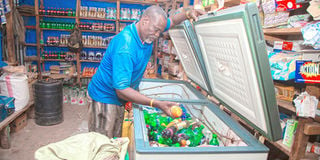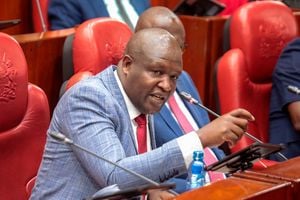How mini grids have revitalised livelihoods for displaced people in Kalobeyei
Sponsored by GIZ

A trader at Kalobeyei Integrated Settlement stocks up a deep freezer with cold drinks. Reliable energy from the solar mini grid has enabled businesses and households to increase their productive activities and grow incomes.
Less than a decade ago, activities at the Kalobeyei Integrated Settlement in Turkana West would set with the sun.
At night, households in the area, set up in 2015 as a settlement for refugees to decongest the Kakuma Refugee Camps, were lit by kerosene lamps, including the sooty tin-wick lamps. There would be the occasional solar lanterns as the cost of solar energy gradually reduced. Only larger institutions would enjoy more reliable electricity, mostly from polluting diesel-powered generators.
Today, however, the situation is different, with many households, businesses, and institutions at Kalobeyei enjoying reliable, affordable, and clean electricity.
With prospects of the national grid extending to refugee settlements not anywhere near the horizon, the recent setting up of a solar mini grid, complete with a distribution network that takes electricity from the plant to the load centres in Kalobeyei settlement’s villages 1, 2, and 3, is a welcome investment.
Initially existing as a 60-kilowatt (kWp) solar mini grid commissioned in 2019 serving approximately 500 customers, the Kalobeyei settlement solar plant’s generating capacity was expanded in 2022 to serve more households and businesses.
“When the pilot was commissioned, it demonstrated clear demand for electricity services. Those who were not connected to the mini grid began requesting its expansion, to reach them,” said Mr Jackson Mutonga, the Deputy Programme Director of the Energy, Transport and Climate Change Cluster at GIZ Kenya.
The expanded plant entails the solar generation facility with an installed capacity of 541kWp, a Battery Energy Storage System (BESS) with a 1.1-megawatt hour (MWh) capacity, and a 58.2km power distribution system of low and medium voltage lines. It is operated by private mini grid developer, Renewvia Energy Limited.
The expansion works were completed through a multi-stakeholder cooperation bringing together public, private, humanitarian and development actors. For example, the project’s generation infrastructure was co-financed by the private company and IFC through its Kakuma Kalobeyei Challenge Fund (KKCF), implemented by the Africa Enterprise Challenge Fund (AECF). Expansion of the distribution network received support from the German Federal Ministry for Economic Cooperation and Development (BMZ), through the Energy Solutions for Displacement Settings (ESDS) Project, which is implemented by GIZ as a component of the global programme – Support to UNHCR in Facilitating the Operationalisation of the Global Compact on Refugees in the Humanitarian-Development-Peace Nexus (SUN).

Doreen Ereng, a Renewvia technician mounts solar panels during Kalobeyei mini grid generation plant expansion.
The ESDS project in Kenya, being implemented since July 2019 and ending in December 2024, aims at promoting market-based approaches for sustainable and efficient energy service delivery to refugees and host communities. The project collaborates with regional and national governments to create an enabling environment for further investments in modern energy access projects in line with Kenya’s national and county strategies and plans.
Today, the mini grid has connectivity of over 2,700 customers, comprising businesses, households, and social institutions, thereby benefiting an estimated catchment of 47,700 refugee and host community members who reside in Kalobeyei Settlement. There are ongoing generation and distribution network expansion works aimed at connecting more households, including two nearby host community villages.
A few kilometres away from Kalobeyei settlement is the Kalobeyei town mini grid, which originally existed as a 20kWp plant serving approximately 129 customers, but has recently been expanded to a 60kWp solar plant. Like the Kalobeyei settlement mini grid, its customers faced power rations prior to the expansion due to increased demand. Kalobeyei town is a small urban centre with a population estimate of 2,500 people, and is gradually developing as electricity opens the business environment.
“We have witnessed the transformative effect of the mini grid on both the refugees and the host community. It is as if it has awakened their dormant potential. With access to electricity, they have realised they can engage in productive activities beyond their usual routines,” said Mr Mutonga.
“This is a paradigm shift representing a fundamental change from reliance on humanitarian aid to active participation in economic activities. It has broadened their perspectives, opening new opportunities for them to engage in various productive activities, promoting self-employment and formal employment within businesses in this context.”
Mr Mutonga further explained that while the expanded mini grid reached more people with reliable electricity, not all households and businesses had been covered, adding that there was a need for further upscaling.
He said that the ESDS project had supported Renewvia, the mini grid developer and operator, in doing a feasibility study, and offered technical advisory as the firm looks at expanding the mini grid to cover more households, businesses and institutions in Kalobeyei.
“The mini grid supplies reliable round-the-clock electricity to villages 1, 2, and 3, but not universally, meaning that not everyone is connected to this mini grid. It still needs further expansion,” said Mr Mutonga.
The mini grid uses prepaid smart meters where consumers top up to buy electricity units while the operator can monitor the system remotely, easily picking up any faults on the system, allowing for fast response.
Kennedy Odhiambo, Regulatory and Customer Service Manager at Renewvia Energy, which built and operates the mini grid, said there were many opportunities for the community during the project’s construction phase.
“During the construction, we incorporated the community. We would use a 50-50 formula to share opportunities between people drawn from the refugee camp and the host community. In this case, we hired 40 people from the refugee camp and 40 from the host community. Out of the 80, at least 30 were women,” he said.
He said that in the operationalisation phase, Renewvia had hired eight employees from the refugee and local community. They oversee different aspects of the plant. They include technicians, security and site agents, who deal directly with customers.
“We have eight employees from both the host and refugee communities, and we have employed the same criteria, where the opportunities are shared between the communities, as well as ensured that there is gender balance,” said Odhiambo.
Before the construction of the solar mini grid at Kalobeyei settlement, large institutions would generate electricity through expensive and environmentally harmful fossil fuels. The same energy source was used to power much smaller grids, each distributing power to a few households or businesses that were also poorly done, such that in addition to health and environmental harm, they did not meet safety standards, posing risks to the users. Access to energy for lighting was also insufficient, posing a security risk, reducing operating hours for businesses, and limiting the time that students could put in for their studies.
The mini grid has promoted the productive use of clean energy to improve self-reliance by boosting livelihood and income-generating activities of refugees and host communities in Kalobeyei.

A welder at work: The solar mini grid at Kalobeyei has given businesses and households access to reliable and clean energy, enabling them to increase their productive activities.
“Before the expansion of the mini grid, the system could not support all the demand, especially from the businesses, but after we commissioned the expanded mini grid, we have not had the customers raise issues of unreliability of electricity. The loads are served sufficiently, and the customers are able to bring even more appliances,” said Odhiambo.
“Previously, businesses that, for instance, had ice making machines or welding equipment, were affected because by 6pm, the power would go off and they had to close shop. The people making ice were not able to store surplus overnight, and this was a loss for them. Today, they are able to do this and it is something that is seen across all businesses and households.”
Residents say with access to reliable energy, which has boosted exterior lighting at night, security has significantly improved. They feel safer. It has also increased their ability to charge phones at home, saving both time and money, and increasing productivity.
Michael Natiira Etaan, a resident of Kalobeyei town, said that with access to affordable and reliable electricity, households and businesses can now use different appliances. This has enhanced livelihoods for households while enabling businesses to offer customers more value.
“Electricity has helped us in many ways. When electricity came, households could use equipment such as fridges. Welders could weld, while school children could go on with their studies after dark. It has also greatly improved security in the area,” he said.
Etaan runs a repair business for mobile phones and other devices. He noted that electricity has enabled him to undertake more complex jobs that have in turn increased his earnings.
“Access to electricity has helped me improve my work in repairing electronics such as mobile phones, radios, and speakers. When repairing these gadgets, I do certain tasks such as soldering, and this has seen my income grow, compared to the time when I was just doing basic repairs,” he said, adding that he is now saving money to pursue further education. Having worked with Renewvia, Etaan’s interest in renewable energy has grown, and he wishes to pursue a course on solar installation.
About Kalobeyei Integrated Settlement
The establishment of Kalobeyei as a refugee settlement area, consisting of villages 1, 2, and 3, was informed by the growing number of refugees that were seeking safety in Kenya, according to UNHCR. At the time, in 2015, the Kakuma refugee camp was hosting a population of 183,000 individuals, against a capacity of 70,000 that it was designed for.
The UN agency says it worked with the County and National Governments to expand land for hosting refugees, and in 2015, the Turkana County Government allocated a 15 square kilometre site near the Kalobeyei Township, situated about 40km northwest of Kakuma.
According to UNHCR, the Kakuma-Kalobeyei refugee hosting area has a population of over 289,861 as of June 2024. The camp and settlement is host to refugees from various countries, including South Sudan, Somalia, Ethiopia, the Democratic Republic of Congo, Burundi, and Rwanda, among others.


